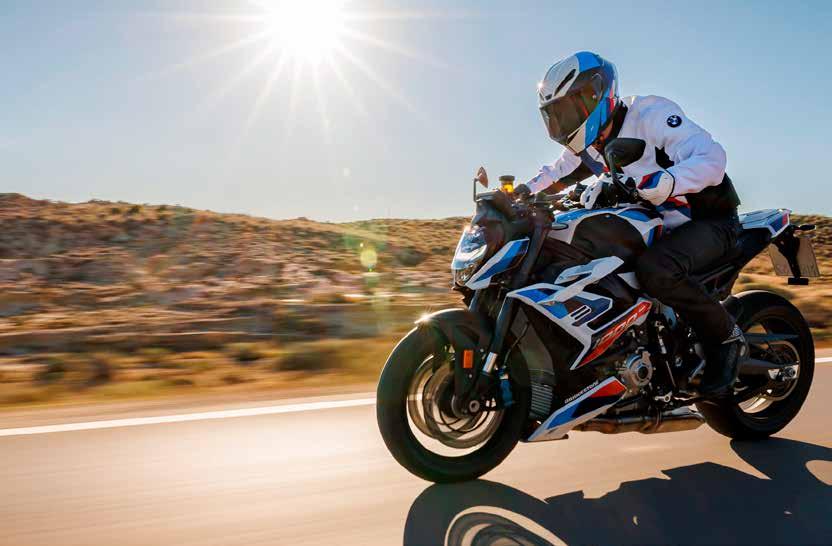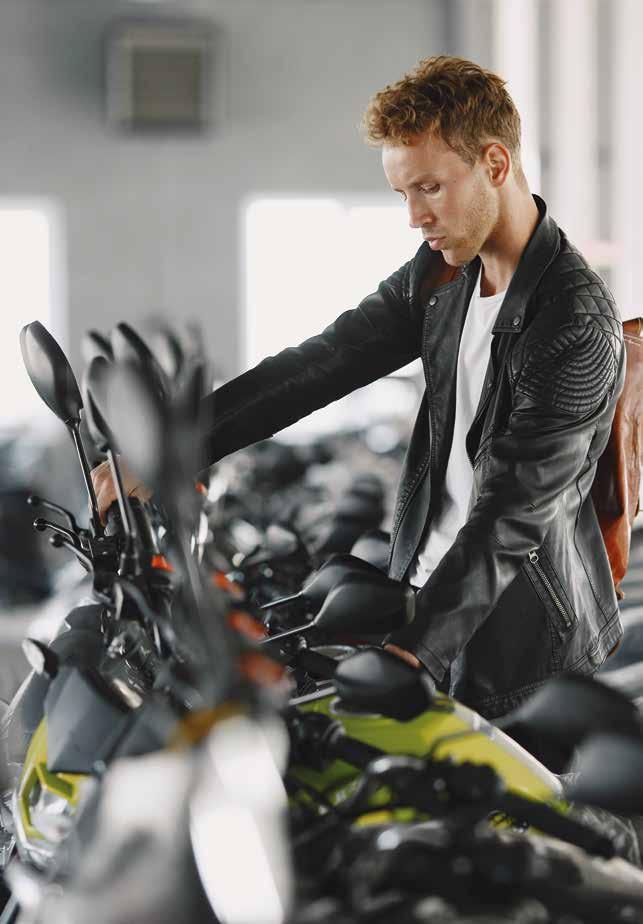
4 minute read
From autobahn to autostrada
BMW: BOXING CLEVER
Although BMW Motorrad’s 2022-unit sales increase was decidedly modest, a premiumpriced model mix made sure the money was right.
Annual revenue from the BMW Group motorcycle division achieved 15.6% growth to £2.795bn. Resultant operating profit grew by 13.2% to £226m. However, operating margin declined slightly, from 8.3% to 8.1%. Pre-tax profit was significantly better, though, 18% up to £237m. Favourable pricing and product mix got the credit, despite higher materials and logistics costs.
Full-year global retail sales volume expanded by a relatively timid 4.4% to 202,895 motorcycles and maxiscooters. Dual impacts from semiconductor supply issues and the Covid pandemic took the blame. Nevertheless, the headline tally stood as a new all-time record.
Deliveries to customers in European markets fell by a marginal 0.3% to 110,788 bikes. German domestic sales topped the pile on 24,129. But that represented a 7.1% loss. Conversely, French riders bought 21,223, a 6.7% rise. Italy was 2.3% down to 15,668 and Spain copped a minor 0.9% retreat to 12,502. According to BDN data, UK sales for the brand sank by 3.8% to 8679.
The three dominant European bike brands on a German-Italian axis all finished the past year in the fast lane, with satisfactorily
Transatlantic performance was brighter, totalling a 14.4% improvement to 45,775. Within that, the USA put on 10.4% to 17,690 and Brazil added 17% to 13,051. Elsewhere, Chinese bikers swerved around strict zero-Covid lockdown measures to buy 15,404 – 7.7% more than in the previous year.
Highlights of BMW Motorrad’s year featured only two completely new models. Billed as a “new chapter in two-wheeled urban mobility”, the CE 04 electric scooter appeared in March. Hugely over-priced, it has since sold in pathetic quantities. And a roadster version of the M1000 superbike was subsequently unveiled. All the rest were revisions – upgrades for a trio of six-cylinder K1600 tourers, fourcylinder S1000RR and M1000RR superbikes, and boxer twin R1250R roadster and R1250RS sports models. Centenary editions of the RnineT and R18 boxer twins are also in the offing for 2023.
While BMW Group executive chairman Oliver Zipse banged on extensively about electrification in his 343-page annual report to shareholders, references to the role for motorcycles were vague and tangental. Synthetic fuels for carbon-neutral internal combustion applications didn’t earn a mention and the closest we got was a nod to “ensuring emissions limits without excluding individual drivetrain technologies and vehicle concepts…”
Zipse’s sole referral to bikes was: “BMW Motorrad will celebrate its centenary this year [2023] with a raft of amazing new models,” he enthused. “I can already reveal that this will also include several for those who prefer an all-electric ride.”
€-£ currency translation at forex rates applicable on 15 March.
DUCATI: WINNING STREAK
If claiming both the MotoGP and WSBK championship titles, respectively thanks to Francesco Bagnaia and Alvaro Bautista, didn’t earn sufficient bragging rights for Ducati’s German masters, then a particularly plump 2022 bottom line for the Italian subsidiary would have kept them happy on its own.
Full-year revenue grew by 24% to £954m, crossing a billioneuro barrier for the first time. Operating profit really excelled, a stunning 77.5% up at £96m. Operating margin improved to 10% from 7%.
Global retail sales hit record levels too, creeping 3.6% higher to 61,562 motorcycles. Ducati’s worldwide best-seller was 10,716 samples of the Multistrada V4 model platform. Monster sales reached 7971 and the Scrambler 800 family followed on 6880 bikes sold.
Biggest individual market for the brand was home turf in Italy, increasing by 10% to 9578 units. Runner-up was the USA, declining by 6% to 8441. Germany came third, rising by 9% to 6678.
Ducati’s global dealer network expanded to a record 821 showrooms by the end of 2022. These included dealerships opening in Brunei, Ecuador, El Salvador and Mongolia, taking the Ducati presence to a total of 96 markets.
Success was not without tribulations, according to Ducati chief financial officer Henning Jens, a trusted pair of German beancounter hands parachuted in by the parent. Commenting on the results, Jens said: “I’m pleased that for the second year in a row we are able to announce a record financial performance and growth in the profitability level for Ducati. Reaching such results despite the supply chain disruption that has heavily affected the automotive sector during the course of 2022 is a remarkable achievement.”
€-£ currency translation at forex rates applicable on 16 March.
PIAGGIO: LA DOLCE VITA?
As clearly expected by investors piling into Piaggio equities prior to numbers being officially crunched, the Italian scooter giant has posted absolute record full-year results for 2022.
Piaggio Group annual revenue hit the highest level ever achieved, 25.1% up to £1.854bn. Operating profit soared by 40.9% to £141m. Operating margin grew from 6.7% to 7.6%. Pre-tax profit stacked on 35.8% to £112.9m. And an alltime record net profit had risen by 41.4% to £75.4m.
Less enthralling was the fact that net debt fell by just £10.7m year-on-year to £325.8m, leaving the company still highly geared.
Revenue from scooters and motorcycles, including related parts and accessories, increased by 23% to £1.49bn, accounting for slightly more than 80% of Piaggio Group’s entire turnover. PTW sales volume worldwide rose by 14.8% to 516,200.
Turnover was particularly strong in the Asia-Pacific region, growing by 57.1%. (Piaggio’s new Indonesian scooter factory, which came on stream in November, will no doubt be set to boost Asia-Pacific revenue considerably further in 2023.) The Americas followed, adding 42.7%. EMEA countries, predominantly in Europe, improved by 10.3%. But sales in India were 5.3% down.

In Europe, Piaggio confirmed its leadership in the scooter segment with a share of 22.9%, up marginally from 22.7% during 2021. It also held positioning on the North American scooter market thanks to a 35.4% share – versus 35% in the previous year. The Aprilia and Moto Guzzi brands apparently “consolidated” their presence in the North American motorcycle segment too, which probably means volume didn’t actually decline. Globally, the scooter sector reported a 14.3% rise in turnover led by the Vespa brand, which recorded an increase of almost 30%.
Worldwide, motorcycles achieved a 19.7% improvement in sales volume and revenue. Aprilia boasted its highest-ever turnover, up more than 30%, with especially strong performances from RS, Tuareg 660 and Tuono 1100 models. Moto Guzzi flagged up record volume and revenue rising by more than 15% too, led by its retro V85TT adventure bike, the V7 range and the new V100 Mandello. However, the studied absence of finite figures has to be a testament to Piaggio’s relatively minor role in the motorcycling firmament.
Commenting on apparent good fortune, Piaggio chairman and chief executive Roberto Colaninno said: “We closed 2022 with our best results ever, setting new records for all indicators. The geopolitical and macroeconomic situation was, and continues to be, complicated. But we are confident and optimistic about 2023 and will continue along the important growth path we have already mapped out.”
€-£ currency translation at forex rates applicable on 3 March.










